Ask Americans to describe Los Angeles in a word, and nine times out of ten you will undoubtedly hear some version of the word “traffic.”
It’s true America, in Los Angeles we know traffic. And traffic congestion: as of March we had over 10 million people in the county of Los Angeles alone; add in adjacent Ventura, San Bernardino and Orange Counties, and you’re talking upwards of 18.5 million. Every year a number of our highways are ranked in the top 10 nationally of worst places to be during rush hour (.... Huzzah?)
So yes, we survive on a steady diet of audio books, hands free phone calls, podcasts (and the occasional fit of total panic).
One word you probably wouldn’t hear mentioned even once if you asked even just Angelenos to describe our city is “green” or “trees” or anything to do with parks. We do have foliage; come in the spring and you will discover blossoming jacaranda more spectacular than anything that poser Washington, D.C., can muster. It’s just spread out over 472 square miles instead of D.C.’s 68.
When it comes to parks, though, Los Angeles struggles. According to a 2015 survey of the Trust for Public Land, of the 75 largest cities in the country, Los Angeles’ parks rank a woeful 51th in terms of access, size and spending per person. Forty-three percent of our children are more than a 10-minute walk away from the nearest park or green space, as are 1.8 million Angelenos in total. That’s more people than live in the cities of Boston, Denver and Atlanta, combined.
In comparison, New York ranked 5th, Chicago 12th and Philadelphia 19th. Cities that did worse include Toledo, Detroit and Newark.
But the possibility of exciting change is afoot. Architect and Angeleno Frank Gehry has been consulting with the city on a proposal to turn the 52 miles that run alongside the Los Angeles River into a “linear Central Park,” complete not just with park land but cafes and performance space. (Knowing Mr. Gehry, there will also be some astonishingly fluid steel structure that haters gonna hate and the rest of us will enjoy.)
It’s very early days, with much work still to be done just on understanding the needs of the river itself. But already, there have been small positive steps, like the city council and Mayor Eric Garcetti’s pledge of $6 million to eliminate over 12 miles of interruptions in the bike and walking paths that run alongside the river. (And when we say interruptions, we’re talking less “picturesque detours” than “nuclear waste dump sites.”)
Meanwhile in Hollywood there is talk of “Hollywood Central Park”, 38 acres of fields and public space placed on top of a portion of the Hollywood Freeway that runs between the more suburban San Fernando Valley and downtown Los Angeles.
The project has been discussed for decades, but in 2006 the Hollywood Chamber of Commerce took up the idea. As of this year the environmental study has been done; the price tag is enormous, something like one billion dollars, but fundraisers believe with some luck construction could actually start as early as next year.
What makes the idea particularly exciting is the opportunity it would offer to the local community. Approximately 40,000 children live within one mile of the proposed park, and those who live in the area have less than half the open space per resident as the city as a whole, which, given how poorly the city fares, suggests how desperate is the need.
How does the world change for the better? Probably the same way things deteriorate: occasionally and spectacularly all at once, but more often than not incrementally, tedious baby steps, one after another. The year 2025 will probably find Los Angeles much the same as it is today—gridlock and concrete and near hysteria medicated only by the soothing tones of Ira Glass.
But little by little, perhaps, that creation St. Paul imagines waiting all around us with eager expectation, groaning with the pangs of birth, will come just a little bit more into life.








